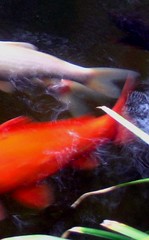at some point in my life, fishing was a way of achieving a timelessness, especially fishing in rivers because rivers have a very timeless quality.
They're always flowing, flowing, flowing.
They're flowing down to the sea.
The clouds form, they float over the countryside, the rain falls, they fill up the ground, the springs…
The stream is kind of this immortal entity, at least in my mind…
and you kind of get swept up in this immortal cycle and kind of lose yourself.
Naming gives us the illusion that nature is fixed, but it is as fluid as the language used to describe it.
It is a challenge of the artist (if no one else) to un-name and re-name the world to remind us that fresh perspectives exist.
James Prosek
On Speaking of Faith last Sunday Krista Tippett interviewed artist, trout fisherman, and something of a mystic, James Prosek. I loved the show.
I’ve written before about the limitations of naming.
Prosek probably shares this critcism, but he arrives there from such a different path it’s well worth walking with him for awhile:
When I was four or five years old, I would draw birds at the kitchen table.
As I finished each piece I asked my mother to write the names of the birds beneath the pictures…Somehow a picture wasn’t finished if the animal’s name wasn’t there.
When I learned to write, I scrawled the common and scientific names of each creature beneath my drawings myself— by example of Audubon, or any others who made paintings in the natural-history tradition.
At nine I developed a passion for trout and began to compile a list of all the diverse types…
As I painted trout through my late teens, major shifts in trout taxonomy were taking place… I began to understand that species were less static than the fathers of modern taxonomy… once believed.
That nature was static and classifiable was an idea perpetuated by the natural history museum (repository for dead nature), the zoo (repository for living nature), and the book (repository for thoughts and images related to nature).
These mediums were all distillations of nature, what individuals of authority deemed an appropriate cross section to present to the public.
None had adequately represented Nature—at once chaotic, multifarious, and interconnected…
I was conflicted—I loved the names that had first led me to recognize the existence of diversity… but as I learned more I wanted to throw away the names, step beyond those constraints, in order to preserve a sense of wonder that I had felt from an early age.
Such thoughts were the origin of the curvilinear lines in my present work….
The first paintings I did with lines emanating from creatures were meant to be imaginings of what God’s or Nature’s blueprint of a particular creature might look like. … The lines activated the space around the animal in a satisfactory way, erasing the need for the name to be written beneath….
James Prosek, The Failure of Names
Such lines also bring to mind the Australian aboriginal Songlines.
During the Dreamtime, archetypal ancestral spirits are said to have wandered across the Earth creating and naming trees, rocks, waterholes, animals and other natural phenomena.
Their dreaming and journeying trails became the songlines, an intricate series of song cycles that identify landmarks and serve as subtle tracks for navigation.
To me, Songlines seem an earthly version of the energy channels and flowing Qi that one becomes aware of through meditation and an illustration of the Taoist emphasis of the connection between macrocosm and microcosm.
That Prosek seems to have discovered similar lines and meanings really delights me.
Click Here, if you’d like to see a “The Myth of Order,” a video of Prosek’s art accompanied by his own narration.
It’s well worth the three minutes –just be patience for Krista Tippett’s face to disappear.
Or, Click Here to see a tattooed Buddha – another artist’s vision of the energy channels?
Thursday, September 04, 2008
Fishing with Mystery
Labels:
dreaming,
fishing,
James Prosek,
qigong,
Songlines,
Speaking of faith,
taoism
Subscribe to:
Post Comments (Atom)


2 comments:
You know - this got me thinking about relationships - we tend to 'name' relationships - slot them into a type and then depending on what'type' we have slotted them under - we expect a certain pattern of behaviour. This leads to expectations and a lot of grief - as when the relationship doesn't behave according to the individual's or society's 'type/slot/pattern' - its headed for pain and disaster...
How much better it could be if we could just let things 'BE'.....
fluid and flowing unhindered...
(in a deeper sense of the word and not to be meant as irresponsible, recklessness! lol!)
Thanks again - for making me think and then some more..
Anjali
Wow! Now, you've got me thinking too. Seems to me that naming and labeling play a huge role in prejudice. "Oh, you're an XYZ, then you must have all these bad qualities."
Bruce Lee was writing about the eyes of a baby, and no mindedness -young children don't have the labels nor the prejudice.
Still, Naming has always carried this mythic power in the good and magical sense too. See, right there I labeled "Naming" as mythical (and by implication not so everyday real) - but, your comment shows naming does create and it creates with huge implications everyday.
Now, I am just going to stop here!
Thanks for writing.
Post a Comment